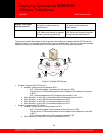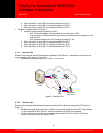
Deploying SpectraLink 8020/8030
Wireless Telephones
May 2009 Best Practices Guide
4 SpectraLink Voice Priority (SVP)
Polycom pioneered VoWLAN for the enterprise and remains the market leader today. One key success
factor has been our SpectraLink Voice Priority (SVP) mechanism for QoS. This method is proven to
deliver enterprise-grade voice quality, battery life and call capacity for SpectraLink handsets.
Quality of service (QoS) is a means of providing a level of service that will result in a network connection
of acceptable quality. Typically this results in providing different levels of service for different applications,
depending on their requirements. When data and voice are competing for bandwidth, such as in a WLAN,
it is necessary to have mechanisms to prioritize voice packets over data, preserve battery life for
handhelds, and allocate appropriate AP bandwidth for the associated device’s applications. The original
802.11 standard did not provide a QoS mechanism, so Polycom developed SVP to allow delay-sensitive
voice and asynchronous data applications to coexist on a Wi-Fi network without compromising voice
quality.
Excellent voice quality for SpectraLink handsets is ensured on a shared Wi-Fi network using SVP.
Adopted by the majority of enterprise-class WLAN vendors, SVP is well-proven and guarantees audio
quality on a shared voice and data network. SVP is compatible with 802.11 standards, but uses
proprietary methods for packet prioritization, battery management and call admission control. Access
points generally use random back-off intervals that require all types of traffic to contend for access to the
wireless medium with equal rights. However, treating all traffic equally can cause significant delays to
voice traffic. Modifying the AP behavior to recognize and prioritize voice packets increases the probability
of better performance while continuing to treat asynchronous data packets normally. The two operations
that comprise SVP in the AP, minimizing random back-off and priority queuing, require a packet-filtering
mechanism. Packet filtering requires recognizing the packet’s type. SpectraLink packets are registered
as IP protocol ID 119 at layer 4. The SVP Server performs packet delivery timing through the AP to the
wireless telephones, which is critical for ensuring seamless handoffs among APs and for enhanced
battery management. The following section offers a more detailed explanation of timed delivery.
4.1.1 SVP Infrastructure
To trigger SVP in the APs from the wired side of the network, a Telephony Gateway with integrated SVP
Server and/or a standalone SVP Server is required. Telephony Gateways can provide SVP support for
small installations with four or fewer Gateways. A SVP Server is required for applications using an IP
telephony server or using more than four Telephony Gateways.
4.1.2 SVP Server Capacity
A single SVP Server supports 120 simultaneous calls when used with Telephony Gateways or 80
simultaneous calls with an IP telephony server. Multiple SVP Servers can be used to increase capacity to
support up to 850 total calls (which can support approximately 8,000 Wireless Telephones) for IP
telephony server interfaces. When used with Telephony Gateways, the total number of users is limited to
640 (40 Telephony Gateways). For smaller IP telephony interface deployments, 10 and 20-user SVP
Servers are available. Refer to Polycom’s SpectraLink 8000 SVP Server Administration Guide
for
additional information regarding the maximum number of simultaneous calls and wireless telephones
supported by multiple SVP Servers.
4.1.3 Multiple SVP Servers
For installations with multiple SVP Servers, call resources are automatically allocated between the APs
and the SpectraLink Wireless Telephones by those devices’ Media Access Control (MAC) addresses. In
18
©2009 Polycom, Inc. All rights reserved.
Polycom and the Polycom logo are registered trademarks of Polycom, Inc. All other trademarks are the property of Polycom, Inc. or their respective companies.


















